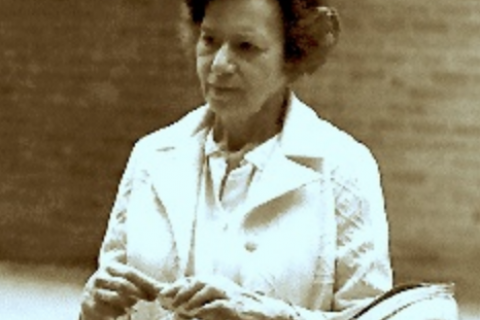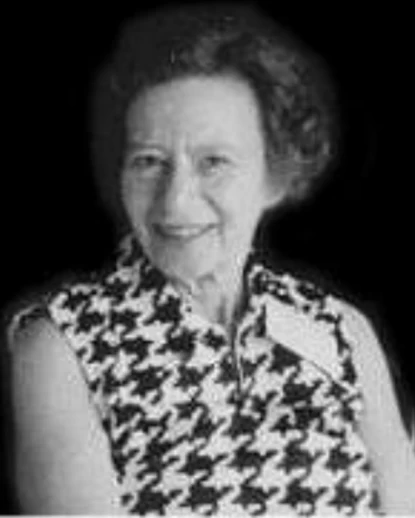

Ladies of Paranormal Past: Gertrude Schmeidler
Parapsychology is a field probably most associated with terms like ESP and telepathy. Often, the first person people think of is J.B Rhine. While he and his wife Louisa who has previously been highlighted in this series made major contributions to the field, Rhine unknowingly had a hand in inspiring another lady who would go on to become a very important figure within the field of parapsychology. In this edition of Ladies of Paranormal Past, we look at the work and life of Gertrude Raffel Schmeidler.
Gertrude Raffel Schmeidler

Image Source: parapsyhc.org
Born in July of 1912 in Long Branch New Jersey, studied at Smith College, Northampton, Massachusetts (B.A. magna cum laude, 1932), Clark University, Worcester, Massachusetts (M.A., 1933), and Radcliffe College/Harvard University, Cambridge, Massachusetts (Ph.D., 1935). It is safe to say she was a very highly educated woman who came across the field of parapsychology and never looked back.
Parapsychology
Gertrude first came by parapsychology by picking up a copy of J. B. Rhine 's first book, Extra-Sensory Perception, (1934). She also took a course in psychical research with Gardner Murphy before completing her Ph.D in 1935. She went on to teach at Monmouth College in Long Branch New Jersey from 1935 - 1937, followed by a research associate position at Harvard University from 1942-1944. Between 1945 to 1946 she was a research officer at the Americal Society for Psychical Research followed by a tenure at the City College of New York from 1945. She became a charter member of the Parapsychological Association from 1958-1960 where she served as Vice President in 1958 and 1960 and President in 1959. She even managed to secure a grant for research from the Parapsychology Foundation.
While she covered many areas within parapsychology such as ESP, out of body experiences and even haunted houses, she is most recognised for her work with studying belief alongside ESP ability, or better known as the Sheep Goat Effect.
The Sheep Goat Effect
In 1958, Gertrude R. Schmeidler coined the term sheep goat effect which relates to the effect that a person's belief and attitude plays on how successful they are in ESP tests. She categorized people into two different areas. Sheep were those who believed in ESP and PSI ability. Goats were those who did not believe. During tests in both solo and group settings, the sheep scored higher than goats.
Schmeidler (1943, 1945) categorized participants in paranormal experiments
as either those who think that ESP is possible under a given experimental
condition ("sheep"), or those who rejected this possibility ("goats").The definition has been extended to include sheep as those who "believe
that ESP exists as a genuine phenomenon" (Thalbourne 2003:114), thus
excluding goats from this belief. Based on pivotal studies (Lawrence 1993,
Palmer 1971, 1977, Schmeidler & McConnell 1973), paranormal belief as
measured on sheep-goat scales tends to be a predictor of psi outcomes, with
sheep producing significant hit rates (i.e. psi-hitting) and goats producing
significant miss rates (i.e. psi-missing). For example, Lawrence's (1993)
meta-analysis of 73 studies (totalling 685,000 trials by 4,500 participants)
dating back to 1947 demonstrated an accumulative sheep-goat effect that
was moderate in size and highly significant - sheep consistently scored
better than goats.Storm,, Lance & Ertel, Suitbert & Rock, Adam. (2013). The Sheep–Goat Effect as a Matter of Compliance vs. Noncompliance: The Effect of Reactance in a Forced-Choice Ball Selection Test. Journal of Scientific Exploration. 27. 393-411.
Following on from this, parapsychologists now often use the term sheep and goat during testing and use it as a scale to interpret results. There is quite a lot of information on this area, and if you would like to read into it further, I recommend reading this entry from the psi encyclopedia which goes into a lot more detail: https://psi-encyclopedia.spr.ac.uk/articles/sheep-goat-effect
A lady of the paranormal
Many women within the paranormal field will testify how hard it can be just being a female in the field. While we have come a long way, there is still a long way to go. Of course with all of her achievements, Gertrude too experienced this. In an interview published on the website Unbelievable, where the interviewer asked Gertrude why she did not work with Rhine the person who somewhat had a hand in her interest in parapsychology to begin with:
"…. here’s an anecdote to show the second major reason: my preferring not to be in an authoritarian society. On one of my delightful, friendly visits to the parapsy lab, always full of good will, I attended a seminar. The staff and visitors sat around a table, with Dr. Rhine at the head. He’d bring up a problem – for instance a request that had to be granted or denied. Anyone who had an idea spoke up, one way or the other. When all had had their say, heads turned to Rhine and there was silence. Then he spoke, telling us the decision … There was no pretense of being first among equals; Dr. Rhine was First.”
Two days later she wrote me, concerned that she had been unfair to J. B., which shows what a decent person she was.
“I told you only a badly incomplete, one-sided impression of J.B. The very same characteristic that made it impossible for me to work contentedly with or under him was a characteristic that made him an important, useful figure in the world. There’s a place for alpha males! In fact, it’s impressed me that most of the (admittedly few) Nobel laureates I’ve known were tall, muscular, powerful men, insistent on achieving their immediate goals and careless about brushing other people out of their way.”
Gertrude paved her own way and was successful in her own right doing things in a way that suited her.
In her own words:
I’m an experimental psychologist, and my research was primarily in perception and memory - until a seminar changed my life. In 1942 I began a part-time job at Harvard (seven years after my doctorate there), saw a seminar on psychical research was offered, and listened in to find what could be said for this bizarre topic. Gardner Murphy’s lectures, and his suggested readings, left me half-fascinated, half-incredulous. Murphy then offered me a stipend from Harvard’s Richard Hodgson Fund to experiment on ESP. I accepted, hoping an experiment would tell me what to think about the topic.
The data convinced me. Repeatedly, average ESP scores of subjects who rejected any possibility of ESP success (whom I called goats) were lower than average ESP scores of all other subjects (whom I called sheep). This was inexplicable by the physical laws we knew; it implied unexplored processes in the universe, an exciting new field for research. From then on, naturally, my primary research interest was parapsychology.
In 1947 I became an instructor at City College, and in due course a professor, teaching only standard psychology. After many years, to my surprise, I was asked to give a parapsychology course for doctoral students, then a similar course for M.A. students, then for undergraduates. But from the first, many of the M. A. theses that I mentored were in parapsychology, and so were, later, five of the doctoral dissertations I chaired.
With student volunteers as subjects I did many small-budget ESP experiments; once even a PK experiment with Ingo Swann, financed by a grant from Carlson, inventor of Xerox. (Good PK apparatus is expensive.) The Parapsychology Foundation helped some projects with its grants. Very great help always came from the wisdom and resources of Gardner Murphy, and from cooperative and brilliant students who joined the research.
My experiments tried to address the criticism that ESP is a fact without a theory; four outcomes seem to rebut it. (1) Personality variables have similar effects on scores in ESP and in other tasks. Psychological theory makes effective predictions about ESP; thus it is a part of ESP’s theory too. (2) Telepathy not only can transmit information, it can also activate a general readiness to use or to inhibit ESP (1961). This aligns ESP processes with theories of social and cultural influences, which also activate or inhibit the use of particular abilities. (3) Precognition can be effective for information never known by any person (targets are randomized and scored by machine but never printed). This extends psychological and social theory; it shows we have access to a wide, unexplored range of stimuli. (4) PK effects in one area are balanced by compensating physical changes elsewhere (1973). ESP seems to show direct access to distant events; PK a direct influence on them. This research explored how PK operates, implying that our influence shifts the balance of physical processes. (I must add that items 2 and 4 above have not been replicated by others; they thus are weaker than 1 and 3.)
To my regret, I could never think of a method that was both rigorous and practical for research on the most exciting possibilities suggested by ESP and PK: problems of the basic characteristics of consciousness or of the self. They await the research of others.
I also held various offices, including the presidency, in the Parapsychological Association and (while it still did research) in the American Society for Psychical Research.
Throughout I depended on my husband’s cheerful tolerance of my professional activity. We have four children and seven grandchildren.
Gertrude published around 200 papers pertaining to her work.
Gertrude Raffel Schmeidler, passed away on March 9, 2009 at the age of 96. She widow of Robert Schmeidler, and a loving mother, grandmother, and great-grandmother
Click here to read ESP and personality patterns
by Schmeidler, Gertrude Raffel (free via public domain). A report on the relation between personality and extrasensory perception, based on data gathered by a psychologist and statistical analysis by a physicist.
References
https://archives.lib.duke.edu/catalog/schmeid
https://www.parapsych.org/articles/14/246/gertrude_schmeidler.aspx
https://www.encyclopedia.com/science/encyclopedias-almanacs-transcripts-and-maps/schmeidler-gertrude-raffel-1912
https://psi-encyclopedia.spr.ac.uk/articles/gertrude-schmeidler
https://www.echonyc.com/~horn/unbelievable/?p=482
If you enjoy LLIFS, consider buying me a book (otherwise known as buy me a coffee but I don't drink coffee and I LOVE books). Your donation helps to fund the LLIFS website so everyone can continue to access great paranormal content and resources for FREE!

Top pages with similar subjects
Don't forget to follow the Facebook page for regular updates
Join the mailing list to receive weekly updates of NEW articles. Never miss an article again!
Buy the latest and past issues Haunted Magazine
Check out the books written by LLIFS